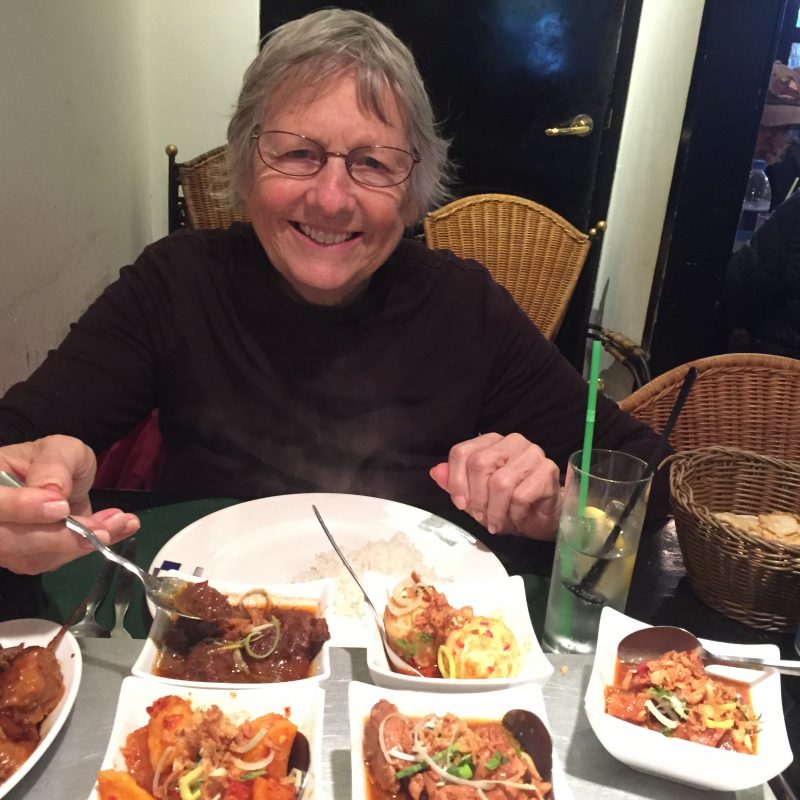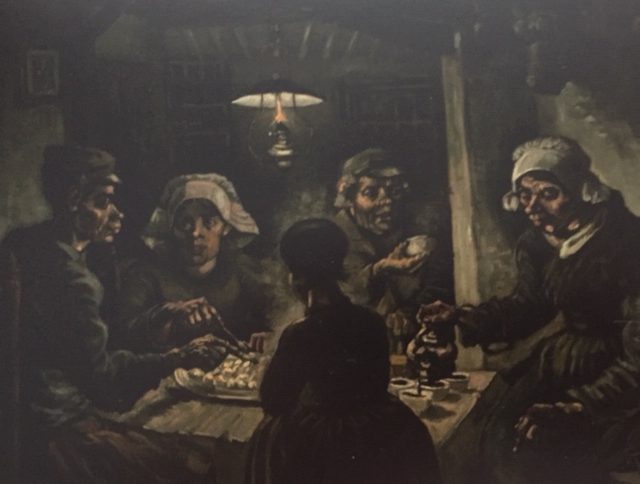
Thoughts on Art, Food, History: Holland & Latvia – Similarities and Differences
It all started when I stood before the Van Gogh painting The Potato Eaters. I could feel myself in a small dark cottage in Latvia, eating mushroom and potato soup, everything tasting smoky and flavored with bacon. From there, the contrasts and comparisons between Holland and Latvia kept emerging. I began my vacation in Fall 2019 in Latvia and ended it in Holland. There was something about both countries that live deep in my soul.

Van Gogh, The Potato Eaters
These two little countries on opposite ends of Europe – Holland (the Netherlands), the most densely populated in Europe with over 15,000,000 people, and Latvia struggling to hold onto its population of almost 2,000,000.
3. Both have been a haven for Jews. In the 16th century, the Netherlands became a center for the Sephardic Jews from Portugal and Spain escaping the Inquisition, bringing their prosperity and their knowledge of sea faring. In the 19th century, Jews escaping mistreatment in Germany and other western European countries were invited into Latvia and Lithuania by the Grand Duchy of Lithuania. Later, the Russian Tsars allowed Jews to settle as part of the swath from north to south known as the Pale. My mother’s and father’s family lived in that area.
4. Both countries underwent wars and struggles to become independent. Holland, along with the southern provinces, became independent from Spain in 1648. In the 19th century, new ideas of liberalism influenced the region, and in 1815, the United Kingdom of the Netherlands became independent under the House of Orange. In 1848, a parliamentary democracy with a constitution was established.
Latvia’s story was very different. In the 16th century, Baltic peasants lost all their rights, became slaves to the German barons who imposed a plantation-like system until the 19th century when the Baltic nobility liberated the peasants. It was kept under domination through the centuries by the empires of the Swedes, Lithuanians, Poles, Germans, and Russians, and it became independent in 1919 which lasted 20 years. Forced into the Soviet Union, Latvia only became independent again in 1991.
The Netherlands was invaded and occupied by the Germans for four years, mainly concentrating on persecuting the Jewish population and sending them to extermination camps. However, when the Dutch resistance grew stronger, the Germans cut off the flow of food, and the Hunger Winter set in, causing tremendous suffering. After the war was over, with the help of the Marshall Plan, the Netherlands regained economic strength and has developed into one of the most developed and wealthiest countries in the world.
The situation in Latvia was more complicated as it was occupied by both the Germans and the Russians. When the Germans marched into Latvia in 1940, Latvia became a front of fighting between the Nazis and the Soviet forces. At first, the Latvians welcomed the Germans, hoping they would drive out the Russians, but they learned their new Nazi rulers were not saviors. Nazis brought Jews from other parts of Europe to Latvia and murdered them as well as Latvian Jews in an extermination camp outside of Riga. As the Germans retreated, Latvia was again under Soviet control, with forced collectivization, deportations, and large numbers of Russians sent to work in factories producing goods for the USSR. With its border on the Baltic Sea and high standard of education, Latvia was often seen by the Soviet military as a great place to be based. With the downfall of the Soviet Union in 1991, Latvia became independent again, although there is still a large Russian population, particularly in the cities.
Why am I thinking so much about history when I try to understand my feelings about Latvia and Holland? I started my trip visiting the Occupation Museum in Riga, as well as the former KGB headquarters and cells. I ended it by visiting the Resistance Museum and Anne Frank House in Amsterdam. As different as the two countries are, similar threads weave through their history, geography, and culture.
Today Holland is secure, a strong economic force, not concerned about being invaded. Latvia does not feel secure because Russian military demonstrations show their strength on the border. Yet, both countries use the euro for currency, are members of the European Union, and are in NATO.
In the background of the tumultuous history of these two lands, there are the stories of people loving, struggling, sacrificing, working, and dreaming. Behind both cultures are the foods that stimulate the senses — the foods that are evoked by Van Gogh’s painting of the Potato Eaters that could just as easily been painted by a Latvian artist of a peasant family on a baronial estate — the smells of bacon smoke and potato steam. Both ends of my Fall 2019 trip in Europe were celebrated with such foods, not the most elegant, but true to their roots.